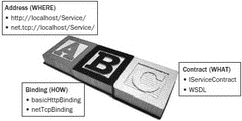Книга: C# 2008 Programmer
The ABCs of WCF
Разделы на этой странице:
The ABCs of WCF
Figure 20-17 shows the ABCs of WCF — address, binding, and contract.

Figure 20-17
? Address — The address that the service is listening at. This indicates where the service can be located and used. The address for a WCF service is dependent on the communication protocol used.
? Binding — The type of binding that you will use to communicate with the service. The binding used determines the security requirements for the communication and how clients will connect to the service.
? Contract — The contract defines what the service offers. The following sections discuss each of these points in detail.
Addresses and Endpoints
Every WCF service has an address and endpoints in which it listens for incoming connections. Figure 20-18 shows a WCF service with two endpoints exposed. A client wanting to use the service just needs to send messages to the appropriate endpoint.

Figure 20-18
The address of a WCF service depends on the protocols used for the service. For example, if a WCF service uses the HTTP protocol, then its address may be:
? http://<server>:<port>/<service>
? https://<server>:<port>/<service>
? https://<server>:<port>/<service>.svc
If a WCF service uses TCP as the protocol, its address is in this format:
net.tcp://<server>:<port>/<service>.
For Named Pipes, the address is net.pipe://<server>/<service>.
A service may have an operation that uses any of the protocols (or all). For example, a service may listen at port 80 (endpoint number 1) using HTTP as well as listen at port 5000 (endpoint number 2) using TCP.
Bindings
The bindings of a WCF not only specify the protocols used but also the security requirements for communication. The following table describes the available bindings:
| Binding | Description |
|---|---|
BasicHttpBinding |
Most basic; limited security and no transactional support. Compatible with traditional ASMX Web Services. |
WSHttpBinding |
More advanced HTTP with WSE security. |
WSDualHttpBinding |
Extends WSHttpBinding and includes duplex communications. |
WSFederationHttpBinding |
Extends WSHttpBinding and includes federation capabilities. |
NetTcpBinding |
Used for TCP communication; supports security, transaction, and so on. |
NetNamedPipeBinding |
Used for named pipe communication; supports security, transaction, and so on. |
NetPeerTcpBinding |
Supports broadcast communication. |
MexHttpBinding |
Publishes the metadata for the WCF service. |
NetMsmqBinding |
Used for MSMQ. |
MsmqIntegrationBinding |
Used for MSMQ. |
The bindings of a WCF determine how a client can communicate with the service.
How to use BasicHttpBinding, WSHttpBinding, and NetTcpBinding bindings is shown later in this chapter.
Contracts
Contracts define what a WCF service offers. The types of available contracts are explained in the following table.
| Contract | Defines |
|---|---|
| Service | All the operations contained in a service. |
| Operation | All the methods, parameters, return types, and so on. |
| Message | How messages are formatted. For instance, data should be included in SOAP header or SOAP message body, and so on. |
| Fault | Faults an operation may return. |
| Data | The type of data used and required by the service. |
- 4.4.4 The Dispatcher
- About the author
- Chapter 7. The state machine
- Appendix E. Other resources and links
- Example NAT machine in theory
- The final stage of our NAT machine
- Compiling the user-land applications
- The conntrack entries
- Untracked connections and the raw table
- Basics of the iptables command
- Other debugging tools
- Setting up user specified chains in the filter table




